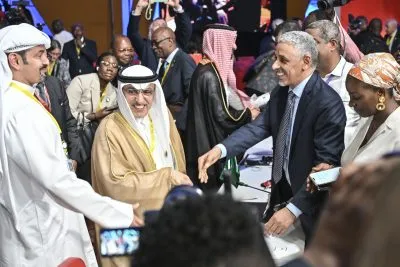This article was produced with the support of PAFTRAC
The discussion delved into key insights from the survey, exploring trends, challenges, and opportunities shaping Africa’s trade landscape under the African Continental Free Trade Area (AfCFTA). Panellists also examined actionable strategies to strengthen intra-African trade, foster economic integration, and enhance the competitiveness of African businesses on the global stage.
Sergio Silva noted that the survey has been conducted yearly since 2020, when trading under the AfCFTA launched. This year 1,388 responses were collected from business executives on the continent.
Silva said that one of the most significant trends observed from the survey is the increasing focus on intra-continental trade. “Africa wants to trade with Africa and you can see it emerging as the most important regional market in terms of both imports and exports,” he pointed out. This, he said, represents a shift from previous editions of the survey, in which Europe and Asia ranked as the continent’s leading trading partners.
Despite this appetite, Silva said the results show that significant challenges persist. Among the top obstacles cited by respondents are currency exchange risks, logistical difficulties stemming from infrastructure gaps, tariff barriers, financial constraints, and limited access to market information.
The survey revealed that around 70% of businesses anticipate high or moderate future benefits, but nearly 75% report little to no current impact and close to 50% indicated no impact at all. “So, I think that the question this brings up is: how do we get there? How do we bridge this gap between what the private sector hope for and what it perceives to be happening now,” Silva questioned.
Following a recurring theme, 25% of respondents this year admitted they were unfamiliar with the AfCFTA itself, and awareness gaps are even more pronounced when it comes to specific operational mechanisms such as the Pan-African Payment and Settlement System (PAPSS). Conversely, Silva said, it is also important for the private sector’s voice to be heard and accounted for in formulating policies around the AfCFTA. “That is the goal of the PAFTRAC survey, to give a voice to the private sector so as to help inform policy making,” he said.
Silva concluded by highlighting some survey respondents’ recommendations. These include increasing support for tech startups through financial mechanisms that encourage risk-taking and innovation, complemented by investment in robust digital infrastructure and skills.
In logistics, respondents pointed to an urgent need for infrastructure enhancements and called for standardisation of cross-border regulations and the implementation. The harmonisation of banking and financial regulations across Africa was a key priority for the sector. An African Open Banking System would further enhance integration.
Colonial flows
Professor Patrick Utomi, chairman of PAFTRAC opened by recalling that the legacy of colonial interventions meant that African countries were more likely to trade with former colonisers than with other African countries. Cross-border trade within Africa has thus long been challenging, even for communities that were once unified but later divided by colonial borders. “It’s very encouraging to recognise today that Africans believe that their future lies in dealing with one another across those boundaries,” he observed.
Conceding that institutional weaknesses remain a barrier to the achievement of the continent’s goals, Utomi urged that “part of our conversation must be to get to the roots of how that can change and change very quickly.” This is important, especially, in the light of isolationist trends in the United States. Africa, he said, must adapt by prioritising intra-African trade and increasing its share of global trade to at least 10%, instead of the current 3%.
Reflecting on the tech sector’s expectations of the AfCFTA, Pren-Tsilya Boa-Guehe said the sector is keen to see the agreement fully operationalised, especially with the promulgation of the digital trade protocols, which would harmonise regulations across the 55 countries. With a population of 1.5bn, she pointed out, Africa presents a vast potential market, yet much of it remains fragmented due to diverse languages and regulatory frameworks.
According to Boa-Guehe, priorities for the sector include harmonisation of regulations, ensuring the smooth flow of data, implementing strong privacy regulations, and enacting laws suited to the digital age. These measures must account for advancements in artificial intelligence (AI) and other emerging technologies, to prevent Africa from lagging behind the rest of the world in innovation.
Corridors are going places
Michael Ngugi trade development officer for the LAPSSET Corridor Development Authority, explained that corridors play a crucial role in enhancing regional connectivity by creating infrastructure that facilitates trade and reduces barriers such as security concerns. For example, the Lamu Port-South Sudan-Ethiopia Transport (LAPSSET) Corridor, a multimodal infrastructure programme, connects Kenya, Ethiopia, and South Sudan. The project aims to unlock 70% of Kenya’s arid and semi-arid regions, while supporting its landlocked neighbours and connecting the region to the other parts of the continent, thereby enhancing trade.
Ngugi added that the project includes the Lamu Port 3 airports, 1,800 km of highways, crude oil pipelines extending from Turkana and South Sudan to Ethiopia, and the Lamu Special Economic Zone, focused on manufacturing and value addition.
Amir Bodylawson said that Afreximbank is trying to bridge the financing gap through a number of measures. One is to provide funding in local currencies, through PAPSS, an initiative of the bank, to reduce reliance on hard currencies.
While many African economies are fragmented and struggle to export at scale, Utomi said the AfCFTA can address that by promoting information sharing, leveraging digital platforms, and strengthening networks through chambers of commerce and other initiatives. “As people get more confident that they can trade across borders, we’ll be able to aggregate significantly, adopt a value chain approach and be able to export at volumes that will lead to a boost in value,” he said.
“It’s going to be critical that our young people have the skills necessary to keep up with the technology that is now available so that they can leverage it for their own development or to create an online business or to reach their target market beyond their physical borders” Boa-Guehe said. Of the 720,000 software developers on the continent 100,000 have been trained through Google programmes she said. “We have invested $50m through our Africa Investment Fund and supported 110 Black-led startups. Our AI research centres are also innovating while investing in local talent to realise Africa’s digital economic potential,” she added.
Spreading awareness
Reacting to the survey finding that only 25% of respondents were fully conversant with the AfCFTA, Utomi stressed the need for collaboration under a “tripartite model of development,” where the public sector, private sector and non-governmental agencies make common cause. “NGOs can play a very critical role in disseminating information and I believe that we need to energise civil society. They can even focus specifically on different economic sectors and make information broadly available in those sectors,” he proposed.
While acknowledging some gaps in knowledge, Ngugi said Kenyan manufacturers are generally well-informed, largely due to the strong presence of the Kenya Association of Manufacturers, which organises seminars and talks. The gaps are more pronounced among small and medium enterprises (SMEs), he said. “I think we should link the manufacturing and private sectors in these conversations so it’s not just about the ideas of the regulators and policymakers, but their views are also integrated as well,” he suggested.


 Sign in with Google
Sign in with Google 



